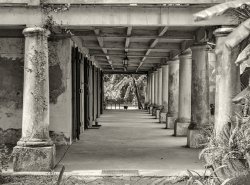
MAY CONTAIN NUTS

Search Shorpy
SHORPY ART

Framed or unframed, desk size to sofa size, printed by us in Arizona and Alabama since 2007. Explore now.
Join and Share
Ad-Free Shorpy
Shorpy is funded by you. Patreon contributors get an ad-free experience.
Learn more.

Recent comments
- If You’re Like Me, Never
- U.S.A.
- S&P
- 1940 Zenith radio model 6G601
- Quality goes in before the name goes on!
- Snazzy skirt
- Carbon Arc Lamps
- Illuminate us
- I remember it well
- I can't prove it
- Complicated then, forgotten now
- Bryan-Stevenson
- Skinny is as skinny does
- How do you rest in peace
- Riding the footboards
- Alas, hidden from view
- Baldwin Diesels
- Exclusive pump
- Bananas, Oysters and Smokey Joe
- Details, Details
- What's that building to the left of the tower?
- Coal Barges
- Bromo-Seltzer
- Inner harbor
- The Basin
- What a headache!
- Giant stepladder?
- Yeah, it was cold
- Love those coats
- Link & Pin Days Remnant
Member Photos
The Shorpy
Print Emporium
Print Emporium
Search Shorpy
Search results -- 30 results per page
- Dear Sis: 1940
- ... most prized family possession." Medium format negative by Russell Lee for the Farm Security Administration. View full size.
1940 Macbook ... Posted by Dave - 07/20/2018 - 7:15pm -
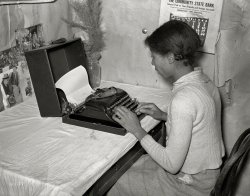
- Playtime Under the El: 1941
- ... on the southside of Chicago." Medium format negative by Russell Lee for the FSA. View full size.
"The baddest part of town" ... Posted by Dave - 09/20/2018 - 12:35pm -
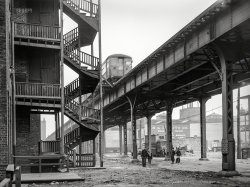
- All Star Minstrels: 1938
- ... "Erecting tent for Lasses White show." Lasses being Lee "Molasses" White (1888-1949), minstrel-show impresario as well as star of ... in the first half of the last century. Acetate negative by Russell Lee for the Farm Security Administration. View full size.
... Posted by Dave - 12/13/2018 - 6:32pm -
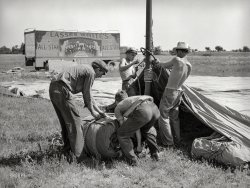
- Baby Steps: 1941
- ... labor camp. Caldwell, Idaho." Medium format negative by Russell Lee. View full size.
Oh, my achin' back! As any parent will ... Posted by Dave - 10/17/2018 - 8:07pm -
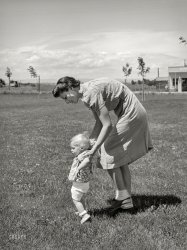
- Williams County III: 1937
- ... Williams County, North Dakota. 35mm nitrate negative by Russell Lee, Farm Security Administration. View full size.
(The Gallery, ... Posted by Dave - 09/08/2011 - 9:36pm -

- Pinstripe Cowboy: 1940
- ... the dream in San Angelo, Texas. Medium format negative by Russell Lee for the Farm Security Administration. View full size.
Laid back and ... Posted by Dave - 06/27/2018 - 10:36am -
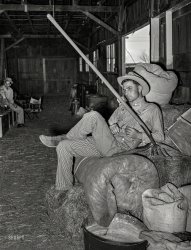
- Tub Tots: 1939
- ... in May Avenue community camp." Medium format negative by Russell Lee. View full size.
Midgets Talk about pint sized.
My ... Posted by Dave - 05/04/2018 - 5:28pm -

- Podcast: 1941
- ... for shipment. Canyon County, Idaho." Acetate negative by Russell Lee for the Farm Security Administration. View full size.
Crate & ... Posted by Dave - 11/17/2018 - 11:31am -
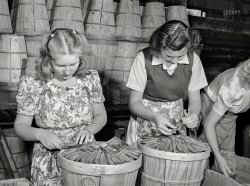
- Death Won Here: 1940
- ... on the highway in Bernalillo County, New Mexico." Photo by Russell Lee for the Farm Security Administration. View full size.
Powerful ... Posted by Dave - 08/15/2018 - 11:09am -
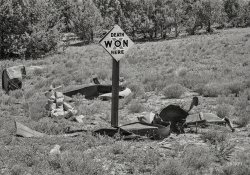
- Park-Vista: 1941
- ... These are rented to Negroes." Medium format negative by Russell Lee. View full size.
Renamed and demolished On a hunch I figured ... Posted by Dave - 09/25/2018 - 11:55am -
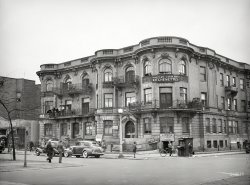
- T for Three: 1939
- ... Lincoln County, Oklahoma." Medium format negative by Russell Lee for the Farm Security Administration. View full size.
Saucered and ... Posted by Dave - 03/26/2018 - 11:54am -
![T for Three: 1939 June 1939. "Migrant workers eating dinner by the side of their car (Ford Model T) while they are camped near Prague, Lincoln County, Oklahoma." Medium format negative by Russell Lee for the Farm Security Administration. View full size.
Saucered and blowedI saw my father drink his coffee that way from time to time and he said it was “saucered and blowed”. I remember seeing my grandmother (his mom) pour her hot coffee into a saucer and blow across the top to cool it off.
That “crystal candy” dish might be a dime store heirloom. I received one similar to it as wedding gift from one of my husband’s aunts who lived in a tiny country town in rural Mississippi in the late 1960s. The only store where she could have shopped would have been a Ben Franklin or other dime store. It was clear glass with a lid that had a silver painted top on top.
I looked closely to see if I could figure out what they were eating. It appeared to be large lima beans, perhaps cooked with a ham hock. My mother in law cooked them with macaroni, making a rather thick, but very filling dish. Loaf bread, served from the wrapper, was served to round out the meal. Carb city.
Grapes of WrathA few weeks ago, I commented on a 1920-something Auburn sedan that looked good as new after more than ten years on the road. This Model T, by contrast, has clearly been put through the wringer.
The Joad Family drove a '26 Hudson, not a Model T, in the movie version of Grapes of Wrath. However, this car reminds me of theirs.
They set a nice blanketThat's a nice, er, table setting for itinerant migrant workers. That fine china and that beautiful crystal dish, probably handed down from parents or grandparents, seem incongruent to people today who are used to seeing plastic utensils and paper plates and cups when eating on the road.
Shades of prosperity pastThey're eating off what I'd assume is the last of the china they used to own, Dad's wearing a good pair of men's shoes, and the lady (Mom? daughter? sister? I can't tell) is wearing her "Sunday go to meeting" dress. The boy on the right has outgrown the clothes they had in the good days, though. I bet it's Sunday and they just went to church.
And that's gotta be tight in that Model T to have all your clothes, cookware, and probably a tent in there. Wow.
Laurel & HardyReminds me of the picnic scene at the front yard of the mansion from the movie "It's A Gift"
[In which Laurel & Hardy were played by W.C. Fields. -tterrace]
PronunciationShould you find yourself in this part of the country, be advised that "Prague" rhymes with "vague."
There's also a Miami, Oklahoma, which isn't pronounced how you might expect. But that's a comment for another photo.
Hood Ornament?Is that a flying duck on top of the crumpled front fender - right in front of the headlight?
Ett fika, kanske?My maternal grandfather invariably drank his coffee the same way: milk and sugar while in the cup, then into the saucer for further cooling and subsequent ingestion. He was the son of Swedish immigrants, and since Grandma didn't take her coffee like that, I figured he'd picked the habit up from his folks and it was therefore a Swedish thing. Never asked him about it, though.
So what about your grandma, Grammy23? Was she, or her folks, from up around these parts?
Proper pronunciation of Prague, OklahomaLocally pronounced "pray"
(The Gallery, Cars, Trucks, Buses, On the Road, Russell Lee)](https://www.shorpy.com/files/images/SHORPY-8b22008a.thumbnail.jpg)
- Williams County II: 1937
- ... Williams County, North Dakota. 35mm nitrate negative by Russell Lee, Farm Security Administration. View full size.
(The Gallery, ... Posted by Dave - 09/08/2011 - 9:40pm -
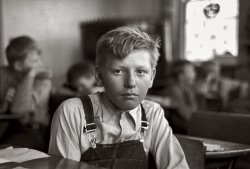
- Spring Forward: 1942
- ... the United States and the Azores are the same'." Photo by Russell Lee for the Foreign Information Service of the U.S. Office of Coordinator of ... Posted by Dave - 03/13/2021 - 7:21pm -
![Spring Forward: 1942 April 1942. "Portuguese-Americans in California. Mr. H. Ormond, who is a leading jeweler in San Leandro, came to the United States from the Azores Islands 23 years ago when he was 17 years old. For three years he lived in San Francisco and then moved to Oakland, where he worked in a jewelry store for ten years. In 1932 he opened his own store in San Leandro. Mr. Ormond and his wife have worked long hours to build their establishment and now hold a respected position in the social and business life of San Leandro. Mr. Ormond said, 'I received my education as a boy in the Azores but I have found that all the things that I learned there as well as the principles of honesty and integrity and thrift and industry that my parents taught me have served me well in my adopted country. While I now speak a different language, all the principles of life in the United States and the Azores are the same'." Photo by Russell Lee for the Foreign Information Service of the U.S. Office of Coordinator of Information. View full size.
Assignment: nationalities in CaliforniaIt's astonishing how a Shorpy photo of a man holding a clock in a town outside San Francisco evokes complex but little-known international politics during World War II.
Lee took this photo the same month as the one of Japanese 'evacuees' that recently sparked spirited commentary on Shorpy. The 'Foreign Information Service of the U.S. Office of Coordinator of Information' was in the same alphabet soup as the Office of War Information that is credited on Lee's photo of Japanese-Americans.
It would be interesting to know the specifics of Lee's assignment during April 1942, though one motive is not difficult to figure. Portuguese-Americans were particularly important because neutral Portugal was one of the few places in continental Europe not under strong German influence. (Dictator Salazar ran a government not unlike Spain's, but disliked Franco's ties to the Axis.) That made Portugal a key destination for refugees and a jumping-off place for the Western Hemisphere. (Characters in 'Casablanca' are trying to get there.)
Mr. Ormond's origin in the Azores is particularly noteworthy because both sides were eying the strategic location of that archipelago in the mid-Atlantic. While maintaining neutrality into 1944, Salazar's government gradually increased the Allies' access to the Azores, something that continued into the Cold War--and today.
Tik-Tok-Tik-TokTry to sleep with one of those in the room. Let's just say they keep you up until you surely miss the alarm.
Ask me how I know.
The AzoresThis one has me all nostalgic this morning. My wonderful grandfather, like Mr. Ormand here, came to the US from the Azores. He arrived as a stowaway in Key West circa 1915, worked his way up the coast to his relatives in New Bedford, Mass. and then fibbed his way (he was about 16) into the US Army. He was gassed and wounded in The Battle of Belleau Wood, met my German grandmother as part of the occupation in 1918 and eventually made his life in Brooklyn as a welder & pipefitter in the Brooklyn Navy Yard. The pic I've upload shows my Mom holding me in early 1953. My Dad is on the left, my grandfather on the right. The other two ladies are my aunts, my fathers sisters.
Seems that Mr. Ormond, like my Pop, found a place here and prospered. Part of our unique blended culture.
Enough to Wind Him UpDaylight Savings days were probably not Mr. Ormond's favorite days of the year.
[DST was instituted 365 days a year during the war, so Mr. O got a reprieve. - Dave]
Daylight Savings EYAHHHHHHH!Love the clocks, love the photo, but thinking of all those clocks and Daylight Savings is giving me acid reflux. And I thought **I** had a lot of clocks to change!
Scream AlarmIs that an Edvard Munch clock just over Mr. Ormond's right shoulder?
Wondering how that alarm might sound.
The time of his lifeYesterday I ate a clock.
It was very time consuming but I went back for seconds.
A woof not a screamThe clocks at both of Mr. Ormond's shoulders look like puppy clocks to me. And one of my aunts had the cat clock with the tick-tock tail.
(The Gallery, Russell Lee, Stores & Markets)](https://www.shorpy.com/files/images/SHORPY-8d04013u.thumbnail.jpg)
- After the Gold Rush: 1940
- ... San Juan County, Colorado." Medium format negative by Russell Lee. View full size.
All that glitters. I was trying to find out ... Posted by Dave - 09/02/2018 - 9:33pm -
![After the Gold Rush: 1940 September 1940. "Abandoned gold mill east of Silverton, San Juan County, Colorado." Medium format negative by Russell Lee. View full size.
All that glitters.I was trying to find out which mine this was, but it was rather like trying to find a needle in a haystack because there were a LOT of mines, both gold and silver, in that area. A few years ago, however, the hazards of all that mining became a very pressing concern.
https://www.csmonitor.com/USA/2015/0810/Animas-River-spill-How-Colorado-...
There are over 20,000 mines burrowed into the mountains in Colorado. It's really only a matter of time before something like this happens again, which is horrid news for the environment and for wildlife in Colorado.
[Even back in 1940, photographer Lee made note of the yellow streams of the Animas River Valley. - Dave]
It boggles the mindJust look at all the effort that went into building those buildings. Look at the many windows in that structure on the incline, and think that this was all done without power tools, not counting the sawmill that milled the lumber. It boggles the mind to think what our ancestors could do with the tools and resources they had.
There's gold in them thar tailingsAbout 1948, at age 14, my friend's dad would drive into the mountains near Denver and stop where there were mill tailings. We would take a batch home, crush the rock, and pan for gold with a pie tin. Over time, we collected about an ounce of gold flakes. Gold at that time was price-controlled at $35 an ounce.
Silver Lake Mill along the Silverton NorthernThis is the Silver Lake Mill along the old Silverton Northern RR line to Animas Forks. It stands at the foot of Arrastra Gulch. Behind the photographer on the west bank of the Rio de las Animas is the Mayflower Mine, which can still be toured. There's a lot less of the Silver Lake Mill left than shown here.
An excellent reference to the area is The Rainbow Route by R. Sloan and C. Skowronski (Denver: Sundance, 1975). I model the areas around Silverton in HOn3.
(The Gallery, Mining, Russell Lee)](https://www.shorpy.com/files/images/SHORPY-8b26298a1.thumbnail.jpg)
- E.L. Bowman Grocery: 1940
- ... plains. Dawson County, Texas." Medium format negative by Russell Lee. View full size.
Poster Boy Alvin R. ... Posted by Dave - 06/17/2018 - 6:28pm -
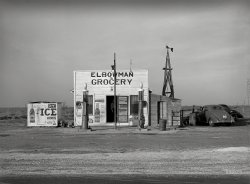
- The Egg and I: 1940
- ... Maricopa County, Arizona." Medium format negative by Russell Lee for the Farm Security Administration. View full size.
Poultry ... work or architecture."
(The Gallery, Agriculture, Russell Lee) ... Posted by Dave - 07/26/2018 - 4:13pm -
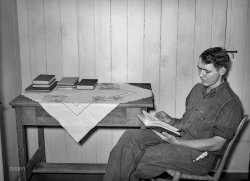
- Fair Ladies: 1942
- ... Young people at the Imperial County Fair." Photo by Russell Lee for the Office of War Information. View full size.
(The Gallery, ... Posted by Dave - 01/29/2017 - 8:23pm -
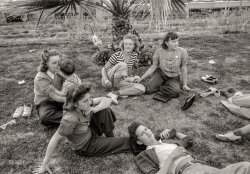
- Joyride: 1941
- ... at Vale, Oregon." Medium format acetate negative by Russell Lee for the Farm Security Administration. View full size.
Oregon vs. ... Posted by Dave - 10/30/2018 - 5:27pm -
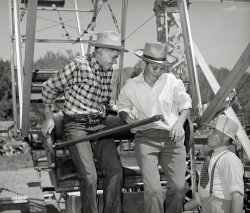
- Up a Tree: 1942
- ... "Boys in city park on a Sunday afternoon." Photo by Russell Lee for the Office of War Information. View full size.
Our Arboreal ... Posted by Dave - 03/18/2016 - 9:21pm -
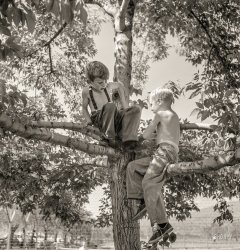
- Night Moves: 1941
- ... service station near Chicago." Medium format negative by Russell Lee for the Farm Security Administration. View full size.
Plymouths and ... Posted by Dave - 12/04/2018 - 5:19pm -
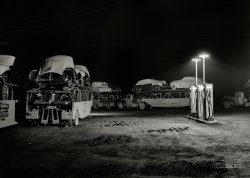
- The Stag Table: 1940
- ... Casa Grande Valley Farms. Pinal County, Arizona." Photo by Russell Lee, Farm Security Administration. View full size.
A Cooperative is not ... Posted by Dave - 12/03/2020 - 1:37pm -
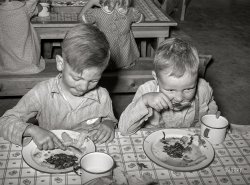
- Family Cart: 1937
- ... Shawneetown, Illinois." Medium format nitrate negative by Russell Lee for the Resettlement Administration. View full size.
Mule haircut ... Posted by Dave - 10/05/2015 - 9:35am -
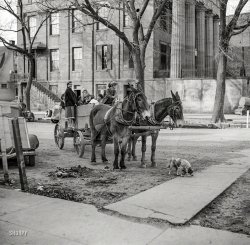
- Idaho Hay: 1941
- ... Canyon County, Idaho." Medium format acetate negative by Russell Lee for the Farm Security Administration. View full size.
(The Gallery, ... Posted by Dave - 09/02/2019 - 6:17pm -
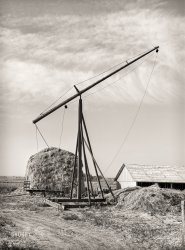
- Board Room: 1940
- ... room of migratory labor camp at Sinton, Texas." Photo by Russell Lee for the Farm Security Administration. View full size.
Master switch ... Posted by Dave - 06/18/2018 - 7:02pm -
![Board Room: 1940 March 1940. "Ironing room of migratory labor camp at Sinton, Texas." Photo by Russell Lee for the Farm Security Administration. View full size.
Master switch and master patternIt looks like each iron outlet has its own pilot light to indicate that the power is on. I wonder if perhaps all the outlets were controlled by that switch near the door - that way, somebody could shut down all the irons in the room with one switch, when laundry time was over, or at night.
That far ironing board support also sports either the carpenter's pattern, or the piece in the "kit" that was labeled (if it was made elsewhere and shipped to the site). The top line pretty clearly says "IRONING BOARD", but the bottom line is more garbled - "CENTRAL VT"? - perhaps a misspelling of Sinton.
[CENTRAL UTILITY. - Dave]
(The Gallery, Kitchens etc., Russell Lee)](https://www.shorpy.com/files/images/SHORPY-8b24294a.thumbnail.jpg)
- Progressive Farmer: 1940
- ... They are equipped with electric refrigerators." Photo by Russell Lee for the Farm Security Administration. View full size.
Defrost Cycle ... Posted by Dave - 08/30/2018 - 11:12am -
![Progressive Farmer: 1940 November 1940. Tulare County, California. "Corner of kitchen in Schmidt house at Mineral King cooperative farm. They are equipped with electric refrigerators." Photo by Russell Lee for the Farm Security Administration. View full size.
Defrost Cycle NeededThe defrost cycle is manual. Take everything out, put a bowl under the freezer compartment, put towels out, and let thaw.
Chip away the ice when it gets loose enough.
Put everything back in.
Wow, time to defrostLooks like it has been some time since the freezer section has been defrosted. My '46 GE refrigerator needs the same attention at least twice a year.
Second shiftI can just hear my mother (of the same vintage as pictured): "Her socks and shoes are a disgrace, but you could eat off her kitchen floor."
Living on a farm in California, I'd be inclined to overlook the icetrays and shoes. Farm wives of any vintage work two jobs: the farm and the house. Keeping field dirt off her floors is a pretty admirable job.
Never with a knifeAn emergency-room doctor once told me a freak tale of defrosting an old-style fridge badly. A guy was hacking away at the ice on his freezer compartment and he pierced the metal, hitting a tube. A jet of freon whooshed out, which the guy inhaled directly. He had an immediate heart attack and died. (By the time I heard this tale, my old-style freezer defrosting days were over, and good thing too, since my own method was to place a pot of hot water underneath and then stab at the ice with a heavy blunt knife.)
So little spaceAnd no tupperware. Bowls, cups, and paper bags.
Is that a linoleum floor? It's not very well put together. I love the poor little flowers above the sink and the woman's well-worn shoes and socks.
Photos like this make me appreciate what I have.
[These people were living in a brand-new house, back when most farmhouses lacked electricity and many had no indoor plumbing. - Dave]
(The Gallery, Kitchens etc., Russell Lee)](https://www.shorpy.com/files/images/SHORPY-8c00102a.thumbnail.jpg)
- Fiesta Selfies: 1940
- ... at the fiesta at Taos, New Mexico." 35mm negative by Russell Lee for the Farm Security Administration. View full size.
(The Gallery, ... Posted by Dave - 10/27/2014 - 1:10pm -
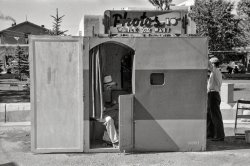
- This Land: 1940
- ... farmer and his son. Placer County, California." Photo by Russell Lee for the Farm Security Administration. View full size.
The Year ... Posted by Dave - 09/19/2018 - 2:11pm -
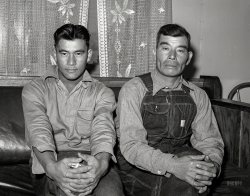
- The Farmer's Quarters: 1937
- ... on cut-over land near Northome." Medium format negative by Russell Lee for the Resettlement Administration. View full size.
(The Gallery, ... Posted by Dave - 03/01/2016 - 10:43pm -
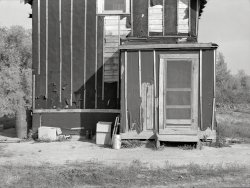
- Questa: 1939
- ... before we motor west. Medium format acetate negative by Russell Lee for the Farm Security Administration. View full size.
Indian(a) ... Posted by Dave - 06/19/2018 - 11:25am -
![Questa: 1939 September 1939. "Street scene. Questa, New Mexico." One last look at the business district of this bucolic burg before we motor west. Medium format acetate negative by Russell Lee for the Farm Security Administration. View full size.
Indian(a) Gasoline, father of TexacoIndian Refining Company was one of the ancestors of Texaco. I found this page with a history of Indian Asphalt/Indian Refining of Indiana (only sort of), Havermeyer Oil (the creators of Havoline motor oil), and Texaco in all its variations.
Given how Indian and Texaco's histories are intertwined, I'm not the least surprised to find an Indian pump installed at a station sporting a Texaco sign.
Indian GasThe nearer pump globe sports an "Indian Gas" logo. Who has the dope on Indian brand gasoline? Bet those globes fetch a few bucks today.
Am I seeing right?Does the sign by the hood of the car really read "MONEY FOR SALE"?
[No, honey. - Dave]
Tivoli BreweryFounded in 1859, closed in 1969, and reopened in 2016 in its original Denver location.
If These Shabby, Flimsy Walls Could Only TalkThey might say a few things about a rough little town. Excerpt from Another Time in This Place: Historia, Cultura y Vida en Questa (2003) by Tessie Rael y Ortega and Judith Cuddihy:
"“At this time [1943], Questa had the most despicable reputation with anyone else. So Father Smith decided to do something. One day he got an axe and starting tearing down the bridge, the only way out of town. When people saw what he was doing, they were furious. They said, “What are you doing that for?” And Father Smith said, “If I don’t tear down the bridge, it’ll fall down.” The people said, “In that case, we’ll help you.” So they tore it down and then they realized what they had done. “Now we can’t get out of town,” they said. Father Smith said, “I guess you’ll have to build another one.” And they did.
Father Smith lived in a house on top of a hill where the Parish Hall is now located. From there he could see everything that was going on in town—who was fighting, who was hanging out in bars, and so forth. One day he had a police siren mounted on top of his car. Whenever he saw a disturbance, he’d turn on the siren and go down. He said to them, “Did you see it? Did you hear it? Then swallow it.” He succeeded in remodeling Questa. Two years later it won a prize for civil cooperation.”
Lunch SuppliesThe typeface on the Groceries sign looks very modern and a bit out of place compared to the others. Is it neon?
Sipping Four Roses at the Four Roses.That step just outside the door of the Four Roses Cafe seems like it would be trouble for a sober man but a man full of Four Roses Bourbon served by the saucy redheaded Four Roses barmaid would defy gravity and blessed drunkenness if he were able to navigate it and steer a homeward bound course.
(The Gallery, Gas Stations, Russell Lee, Stores & Markets)](https://www.shorpy.com/files/images/SHORPY-8b22880a.thumbnail.jpg)
- Banana Veranda: 1938
- ... near New Orleans, Louisiana." Medium format negative by Russell Lee. View full size.
(The Gallery, New Orleans, Russell Lee) ... Posted by Dave - 06/26/2018 - 11:00am -
